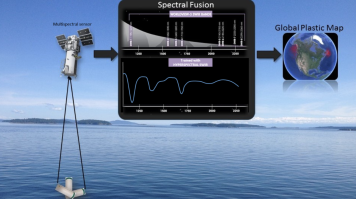Duration: 24 months
Successfully mitigating the damage caused by marine litter requires large-scale, accurate mapping of oceanborne plastics across the globe.
Plastics commonly found as ocean litter have spectral absorption features in the Short-Wave InfraRed (SWIR). SWIR hyperspectral imaging (HSI) sensors can detect and monitor these plastics, as demonstrated in a 2016 airborne campaign over the Great Pacific Garbage Patch. While space-based monitoring of plastics is ideal for wide-area detection and monitoring, there are no currently available spaceborne HSI sensors available for the task. While the bands of current spaceborne SWIR multispectral sensors contain some of the key spectral ranges for plastic detection, the wide bands cause entire absorption features to be captured in single bands, making it difficult to detect plastics reliably. Our idea is to develop deep-learning spectral fusion algorithms that learn to associate multispectral data with full hyperspectral absorption features, so that single multispectral images can be used to detect plastics more reliably. SWIR sensors already on orbit could then better contribute to marine litter detection. Once hyperspectral space assets such as CHIME become available, they could be used for continuous training of multispectral SWIR sensors to allow more coverage and revisit in ocean plastic detection and monitoring. Algorithm training data could be hyperspectral airborne data coincident with WorldView-3 SWIR multispectral in regions of known floating plastics, with ground truth derived from hyperspectral unmixing to identify plastic locations and concentrations. We could augment the data set by simulating spectral signatures of dry and wet plastics in various backgrounds/concentrations and assess how our novel modifications to Generative Adversarial Models or Convolutional Neural Networks currently used for multi- and hyper-spectral applications perform in detecting dry and wet plastics when deployed on multispectral data.

